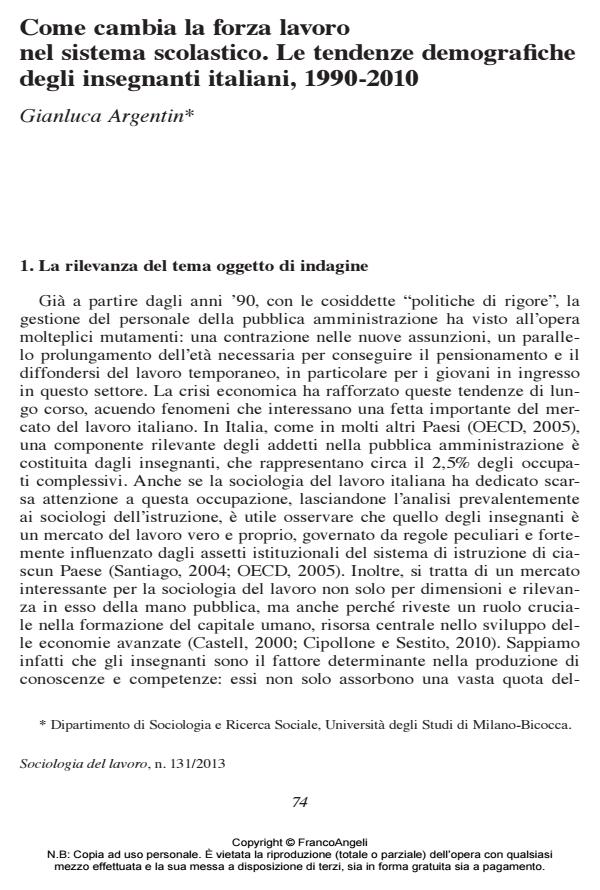Come cambia la forza lavoro nel sistema scolastico. Le tendenze demografiche degli insegnanti italiani, 1990-2010
Titolo Rivista SOCIOLOGIA DEL LAVORO
Autori/Curatori Gianluca Argentin
Anno di pubblicazione 2013 Fascicolo 2013/131
Lingua Italiano Numero pagine 15 P. 74-88 Dimensione file 462 KB
DOI 10.3280/SL2013-131005
Il DOI è il codice a barre della proprietà intellettuale: per saperne di più
clicca qui
Qui sotto puoi vedere in anteprima la prima pagina di questo articolo.
Se questo articolo ti interessa, lo puoi acquistare (e scaricare in formato pdf) seguendo le facili indicazioni per acquistare il download credit. Acquista Download Credits per scaricare questo Articolo in formato PDF

FrancoAngeli è membro della Publishers International Linking Association, Inc (PILA)associazione indipendente e non profit per facilitare (attraverso i servizi tecnologici implementati da CrossRef.org) l’accesso degli studiosi ai contenuti digitali nelle pubblicazioni professionali e scientifiche
L’articolo analizza in chiave di sociologia del lavoro il mutamento demografico degli insegnanti italiani, dal 1990 fino al 2010. Per questa occupazione si sono osservati processi di femminilizzazione e invecchiamento. Solo quest’ultimo è però peculiare degli insegnanti, mentre la femminilizzazione ha riguardato tutto il corrispondente segmento di mercato del lavoro. Il più rapido invecchiamento della popolazione degli insegnanti italiani e la contemporanea crescita del loro svantaggio in termini di maggiore instabilità occupazionale mettono in luce la rilevanza dei processi di reclutamento, modellati soprattutto dalla mano pubblica. Coerentemente con questo aspetto, la recente crisi economica non sembra aver influenzato l’instabilità occupazionale degli insegnanti, perlomeno sino al 2010. Nelle conclusioni si traggono le implicazioni derivanti da questo studio per i sociologi economici e per il disegno delle future politiche di reclutamento degli insegnanti.
Parole chiave:Insegnanti, mercato del lavoro degli insegnanti, femminilizzazione, invecchiamento, reclutamento degli insegnanti, caratteristiche demografiche degli insegnanti
- Are there any job resources capable of moderating the effect of physical demands on work ability? A study among kindergarten teachers Sara Viotti, Mara Martini, Daniela Converso, in International Journal of Occupational Safety and Ergonomics /2017 pp.1
DOI: 10.1080/10803548.2016.1267976 - Giochi di prestigio Gianluca Argentin, in Quaderni di Sociologia /2013 pp.187
DOI: 10.4000/qds.469 - Work ability and burnout: What comes first? A two-wave, cross-lagged study among early childhood educators Sara Viotti, Gloria Guidetti, Ilaria Sottimano, Mara Martini, Daniela Converso, in Safety Science /2019 pp.898
DOI: 10.1016/j.ssci.2019.06.027
Gianluca Argentin, Come cambia la forza lavoro nel sistema scolastico. Le tendenze demografiche degli insegnanti italiani, 1990-2010 in "SOCIOLOGIA DEL LAVORO " 131/2013, pp 74-88, DOI: 10.3280/SL2013-131005